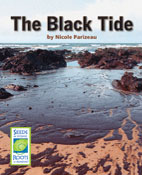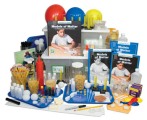Archive for June, 2012
Discovering Ways to Protect Our Shorelines – Helping Elementary Students Understand the Effects of Erosion
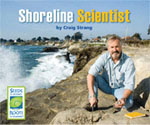 If you asked elementary students where you’d find a scientist, they would likely say the lab. The beach would not be a likely answer, but that is just where they’d find Gary Griggs, a Shoreline Scientist. Every October, we celebrate Earth Science Week. It’s a great opportunity to teach students about erosion and the challenges shoreline scientists like Gary face as they try to understand and mitigate the impact of erosion on shorelines.
If you asked elementary students where you’d find a scientist, they would likely say the lab. The beach would not be a likely answer, but that is just where they’d find Gary Griggs, a Shoreline Scientist. Every October, we celebrate Earth Science Week. It’s a great opportunity to teach students about erosion and the challenges shoreline scientists like Gary face as they try to understand and mitigate the impact of erosion on shorelines.
In Shoreline Scientist, students learn key concepts about why some sandy beaches are endangered. You can help students understand the concept of disappearing sand with the following classroom activity taken from the Seeds of Science/Roots of Reading® Shoreline Science unit:
Draw a picture on the board to help reinforce the sequence of events that causes sandy beaches to get smaller and shorelines to be unprotected.
 a. Draw a mountain, the ocean and a river connecting the two. Say “Water travels from the mountains to the ocean. It carries with it new sand and tiny pieces of rock that will become sand.” Draw sand accumulating at the shoreline and tell students that this is how some sandy beaches form. (Figure 4-8A)
a. Draw a mountain, the ocean and a river connecting the two. Say “Water travels from the mountains to the ocean. It carries with it new sand and tiny pieces of rock that will become sand.” Draw sand accumulating at the shoreline and tell students that this is how some sandy beaches form. (Figure 4-8A)
b. Draw a dam across (more…)
Wow Your Students with the Biggest Animal Ever to Walk on Land!
I felt like a mouse looking up the giant leg of an elephant.” That’s what Rodolfo Coria remembers about his first look at the huge bones of an unknown dinosaur. Coria, and another paleontologist, dug up some unusual bones that had been found in the desert in Argentina. The bones tuned out to belong to a kind of dinosaur that no one had known about before. The paleontologists named the dinosaur Argentinosaurus after their country. Argentinosaurus was bigger than any other dinosaur ever found. In fact, it was the biggest animal ever to walk on land! Here’s a look at the world’s first fully mounted Argentinosaurus (found at the Fernbank Museum of Natural History in Atlanta).
It weighed over 100 tons and measured more than 123-feet-long, the length of nearly three school buses. Uncovered in Patagonia, Argentina, its name means “Argentine Lizard.” This plant-eating creature feasted primarily on conifers and lived 90 million years ago.
Finding the biggest animal ever to walk on land was impressive. Then Coria went on to discover (more…)
Taking Notes Based on Observations with a Sky Notebook
 Elementary students need practice to learn to discern between observations and inferences. The book and Strategy Guide featured in this article gives you the tools you need to teach this important skill. When elementary students learn how to observe, they use one or more of their five senses to take notice of what otherwise might go undetected. You can help elementary students learn to record observations which involves detailed note taking. Below is information you can use to implement a note-taking strategy with your elementary students. It includes the use of a student book called Sky Notebook, but can also be used with other content readers. You’ll also find a pdf link for a FREE Strategy Guide, “Taking Notes Based on Observations“ which expands upon the information in this article.
Elementary students need practice to learn to discern between observations and inferences. The book and Strategy Guide featured in this article gives you the tools you need to teach this important skill. When elementary students learn how to observe, they use one or more of their five senses to take notice of what otherwise might go undetected. You can help elementary students learn to record observations which involves detailed note taking. Below is information you can use to implement a note-taking strategy with your elementary students. It includes the use of a student book called Sky Notebook, but can also be used with other content readers. You’ll also find a pdf link for a FREE Strategy Guide, “Taking Notes Based on Observations“ which expands upon the information in this article.
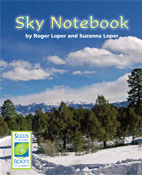 Sky Notebook is set in the mountains of Colorado where winter storms move through quickly. The narrator is an amateur meteorologist who takes measurements and keeps detailed notes to document changes in the weather. Photographs are used to illustrate these observations. National weather maps are also included; they present temperature and precipitation readings in a visual format and supplement the narrator’s observations. Readers can observe changes in the weather—such as amount of cloud cover, temperature, and humidity—as a winter storm moves in. The data presented in the book provide readers with opportunities to make predictions and inferences about the weather, not only in Colorado, but also across the United States.
Sky Notebook is set in the mountains of Colorado where winter storms move through quickly. The narrator is an amateur meteorologist who takes measurements and keeps detailed notes to document changes in the weather. Photographs are used to illustrate these observations. National weather maps are also included; they present temperature and precipitation readings in a visual format and supplement the narrator’s observations. Readers can observe changes in the weather—such as amount of cloud cover, temperature, and humidity—as a winter storm moves in. The data presented in the book provide readers with opportunities to make predictions and inferences about the weather, not only in Colorado, but also across the United States.
Students can read Sky Notebook or another content reader with detailed illustrations or photographs that prompt rich observations and lend themselves to making detailed notes. Here is a copymaster that can be used for (more…)
Drinking Cleopatra’s Tears – A Lesson in the Water Cycle for Elementary Students
 Are you drinking Cleopatra’s tears? That may seem like a strange question for elementary students to answer, but you can tell them that they might be! When Cleopatra was alive thousands of years ago, the water that was in her tears is still on Earth today. The water in Cleopatra’s tears become part of all the other water on Earth. So there could be a tiny bit of that water in anything you drink.
Are you drinking Cleopatra’s tears? That may seem like a strange question for elementary students to answer, but you can tell them that they might be! When Cleopatra was alive thousands of years ago, the water that was in her tears is still on Earth today. The water in Cleopatra’s tears become part of all the other water on Earth. So there could be a tiny bit of that water in anything you drink.
Intriguing questions stimulate students’ imaginations and curiosities. In the Seeds of Science/Roots of Reading® book Drinking Cleopatra’s Tears, students hear humorous questions, the answers to which help them understand how the water cycle works. Questions include:
The answers to these and (more…)
Helping Elementary Students See That Chemical Reactions Are Everywhere
Science labs are not the only places where chemical reactions happen. Have you ever seen bread turn brown in a toaster? If the answer is yes, you have observed a chemical reaction. The Seeds of Science/Roots of Reading® student book Chemical Reactions Everywhere, explains what a chemical reaction is and how to look for evidence of a reaction. Students learn about lots of ordinary chemical reactions that happen in our everyday lives. After reading this book, they will begin to notice chemical reactions everywhere. Below are a few of the chemical reactions featured in the book:
Fireworks explode because of chemical reactions. As they explode, fireworks produce flashes of light. The flashes are evidence that chemical reactions are happening. The reactions are giving off energy in the form of light. These reactions also give off energy in the form of heat, so fireworks are dangerous to handle.
A fresh slice of apple is usually white. Leave the slice out for a while, and it turns brown. That change is evidence of a chemical reaction! Substances in the apple combine with oxygen in the air. A chemical reaction happens, forming new substances with new properties. The new substances make the apple look brown instead of white. The change in color is evidence that a chemical reaction is happening.
Kids often carry glowing light sticks with them on the Fourth of July. To make a light stick start glowing, you bend it until it snaps. The glow happens because of a chemical reaction.
Bending the stick breaks a tube inside the stick. The tube is keeping different substances in the stick apart. When the tube breaks, the substances are able to combine, and this starts a chemical reaction. This chemical reaction gives off light, but not heat. That’s why the light sticks are safe to hold. It is important to note that light sticks have dangerous substances inside and should never be opened.
Other chemical reactions featured in the book include: (more…)
Are birds really dinosaurs? The answer to this and much more about our feathered friends.
Birds are closely related to a group of dinosaurs called therapods – carnivorous dinosaurs with short forelimbs that walked or ran on strong hind legs. Extinct therapods include carnivorous dinosaurs like Tyrannosaurus rex. The first therapods are traced to about 220 million years ago. Today, birds are the only living therapods. Read more in this article from the University of California Museum of Paleontology.
Birds constitute a large group of related organisms, and within the large group are smaller subgroups as described in the following.
Ostriches and Their Kin. Ostriches, emus, rheas, and cassowaries are a related group of birds. They share the identifying characteristics of (more…)
“The World Is Round!”
“We’re not the first to discover this, but we’d like to confirm, from the crew of Apollo 17 that the world is round.” This humorous message was relayed by Eugene Cernan, astronaut on Apollo17’s mission to the Moon. On the way to the moon, Cernan had an amazing view of Earth. After four days of traveling through space, Cernan and his fellow astronauts reached the moon. As they skipped and hopped on the Moon’s surface, they sang a jovial song and their glee was quite evident.[youtube:wo3-fuYKWB4]
Their excitement and enthusiasm is childlike. Many dream of becoming astronauts and experiencing such wondrous moments. However, astronauts are not the only people who get the chance to take part in these missions. Engineers and space scientists also play an important role in space exploration.
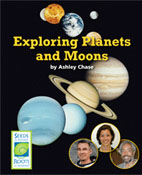 In the elementary student book, Exploring Planets and Moons, elementary students not only learn about the astronauts that landed on the moon, but also an engineer who designs space robots and a space scientist who uses telescopes and other tools to explore parts of space too far away for a spacecraft to reach. This book serves as an introduction to the Seeds of Science/Roots of Reading® Planets and Moons unit and helps students understand that there is a variety of ways to explore the Solar System and beyond.
In the elementary student book, Exploring Planets and Moons, elementary students not only learn about the astronauts that landed on the moon, but also an engineer who designs space robots and a space scientist who uses telescopes and other tools to explore parts of space too far away for a spacecraft to reach. This book serves as an introduction to the Seeds of Science/Roots of Reading® Planets and Moons unit and helps students understand that there is a variety of ways to explore the Solar System and beyond.
In addition to astronaut Gene Cernan, students meet (more…)
Help Elementary Students Understand that Earth is Spinning
It is difficult for elementary students to believe that Earth is spinning around. The ground isn’t moving. If Earth is rotating, why isn’t the sky moving around? If you watched the sky long enough, you would see the stars spinning around.
The picture to the left is the sky at night. The camera wasn’t spinning – Earth was! A photographer set up a camera to point at the sky. He left the camera to take a picture slowly for a few hours. The streaks in the picture are made by stars. These streaks are called star trails.
Star trails are evidence that Earth rotates. The stars seem to move around as Earth rotates. The motion seems to be very slow, but over time stars can leave long trails in a photograph, as you can see.
In the Seeds of Science/Roots of Reading® student book Spinning Through Space, from the Planets & Moons unit, elementary students learn that though the ground beneath their feet may seem to stay still, Earth is actually moving faster than a roller coaster!
Spinning Through Space helps students understand the rotation and orbit of planets in the Solar System. The book is framed around of a series of surprising statements about Earth, day and night, the movement of objects in space, and the length of a year.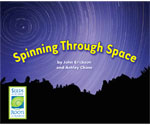
Do you want to be notified when we publish new blog articles? Simply enter your email address in the “Follow Blog via Email” box located in the right sidebar.
